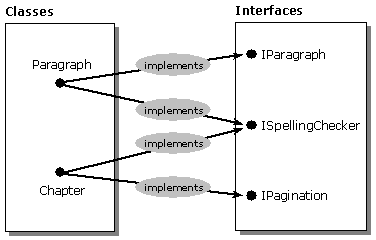
In Automation programs, each object exposes its properties, collections, and behaviors through interfaces. To have the instances of a class exhibit certain behaviors or have certain properties or collections, you implement the appropriate interface for that class.
The Type Information Model accommodates such data by letting you describe interfaces. Each interface can have a set of classes that implements it, and each class can have a set of interfaces that it implements.
The following figure shows some classes and the interfaces they implement. In the figure, the Chapter class implements two interfaces, ISpellingChecker and IPagination. Both the Paragraph class and the Chapter class implement the ISpellingChecker interface.
